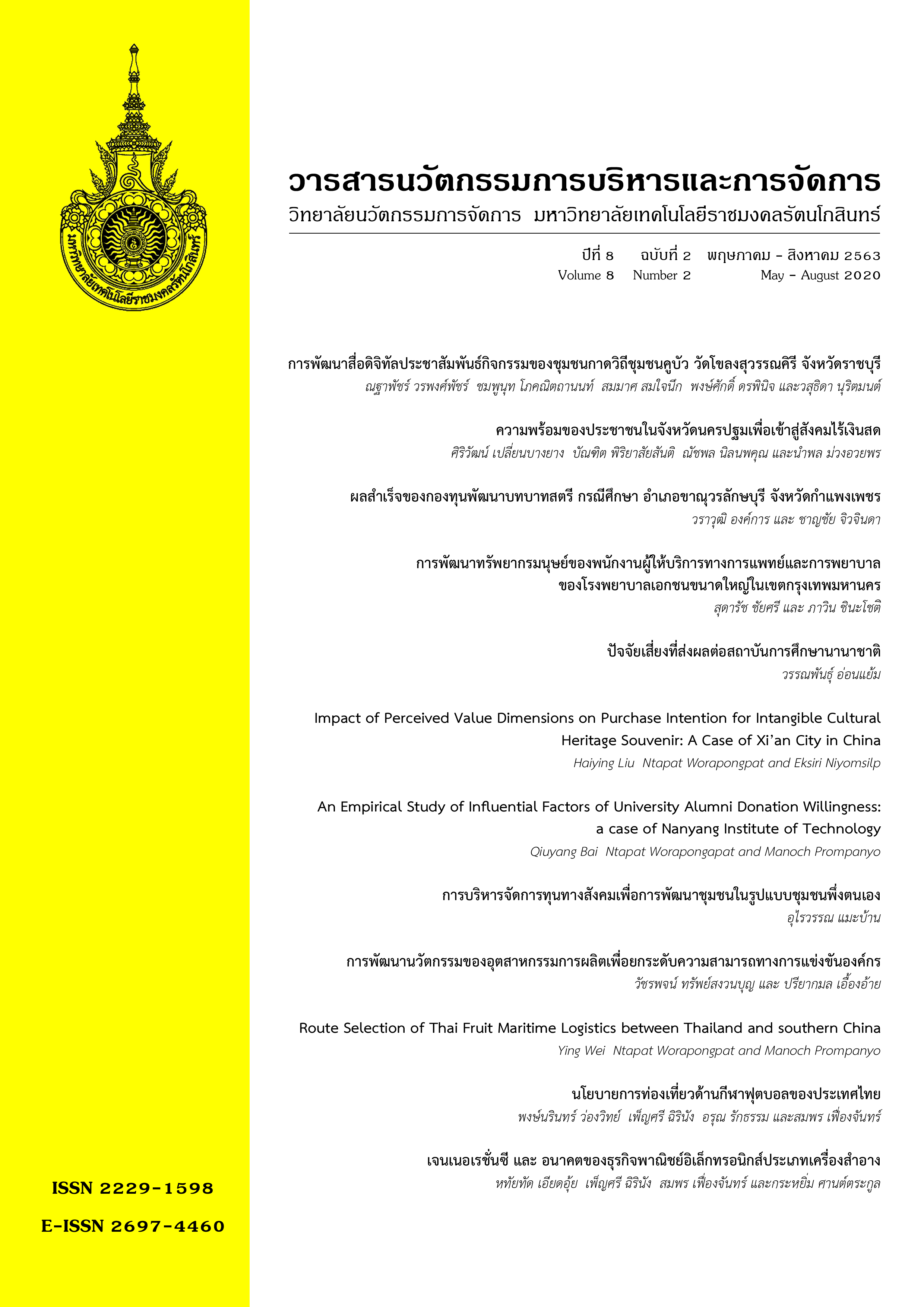Route Selection of Thai Fruit Maritime Logistics between Thailand and southern China
Main Article Content
บทคัดย่อ
Abstract
With the establishment of CHINA-ASEAN free trade area in 2010 and the advancement of the "One Belt and One Road" policy, trade has been heating up between Thailand and China. Thailand is famous for being rich in tropical agricultural products, especially fruit and vegetable with huge export potential. The continuous improvement of logistics network ensures the rapid development of fruit trade. At present, as the fresh fruit is perishable food with high requirements on temperature and humidity, refrigerated container shipping logistics is an important guarantee for the export quality of fruits in Thailand. Therefore, marine transportation is the main logistics mode for the export of fruits and vegetables from Thailand to China. This research study the optimal maritime logistics route between Thailand and China, the paper takes Laem Chabang and Bangkok port as the starting point, and analyzes the factors such as transport cost, transport time, customs clearance and transport capability, comparison these four paths of maritime logistics. Among these, time and cost are quantitative indicators while customs clearance and transport capacity are qualitative indicators, so AHP method is adopted to establish the model.
Article Details
ข้อความและบทความในวารสารนวัตกรรมการบริหารและการจัดการ เป็นแนวคิดของผู้เขียน ไม่ใช่ความคิดเห็นและความรับผิดชอบของคณะผู้จัดทำ บรรณาธิการ กองบรรณาธิการ วิทยาลัยนวัตกรรมการจัดการ และมหาวิทยาลัยเทคโนโลยีราชมงคลรัตนโกสินทร์
ข้อความ ข้อมูล เนื้อหา รูปภาพ ฯลฯ ที่ได้รับการีพิมพ์ในวารสารนวัตกรรมการบริหารและการจัดการ ถือเป็นลิขสิทธิ์ของวารสารนวัตกรรมการบริหารและการจัดการ หากบุคคลใดหรือหน่วยงานใดต้องการนำทั้งหมดหรือส่วนหนึ่งส่วนใดไปเผยแพร่ต่อหรือกระทำการใดๆ จะต้องได้รับอนุญาติเป็นลายลักษณ์อักษรจากวารสารนวัตกรรมการบริหารและการจัดการก่อนเท่านั้น
เอกสารอ้างอิง
2.Boonla T(2012). Logistics management: a supply chain perspective. Bangkok: Se-Educa-tion public company limited(12)
3.Cen Liyang(2008).The construction of port logistics channel in beibu gulf economic zone of Guangxi .Around southeast Asia, (06)
4.Cear ducruet, Sung-woo lee & Adolf K.Y.Ng(2010). Centrality and Vulnerability In Liner Shipping Networks: Revisiting The Northeast Asian port hierarchy. Maritime policy & Management the flagship journal of international shipping &port research, 37(1):17-36
5.Caroteneuto, Giordani & Zaccaro A. (2014). A simulation based approach for evaluating the impact of maritime transport on the inventory levels of an oil supply chain, transportation research procedia, (3):710-719.
6.Clark Ximena,David Dollar,& Alehandro Micro(2004). Port efficiency, maritime transport costs and bilateral trade .Journal of Development Economics, (75):417-450
7.Chen yueying (2012). Current characteristics and development trend of the world maritime economic geography pattern. Integrated transportation, (08):45-47
8.Deng Wen(2016). An empirical study of the impact of China's export trade on port efficiency .Logistics Sci-tech, (08):90-91:18-20
9.Ducruet C,notteboom T(2012).The worldwide martime network of container shipping spatial structure and regional dynamics.Global networks a Journal of transnational affairs ,12(3),395-423
10.Defraeye T, Nicolai B, Kirkman W(2016), Integral performance evaluation of the fresh produce cold chain: A case study for ambient loading of citrus in refrigerated loading of citrus in refrigerated containers. Postharvest biology&technology,112:1-9
11.Drelich-Skulska, Boguslawa(2011). Economic effects of the integration process of China--ASEAN countries.Regional Studies Association (RSA).Newcastle university,.
12.Edward Wong(2010).Chinese Military Seeks Extend Its Naval Power.the New York Times,04,23.
13.Fremont A(2007). Global maritime network: the case of maersk. Journal of transport geography, 15(6):431-442
14.Guancai(1996). Enter the international shipping industry of 21 centuries. Chinese port, (04):4-5
15.Jtianmao,quanshuxian(2001).The relationship between east Asian economic development and shipping industry.China Water Transport, (01):42-45
16.Krugaman,P.A(1991). Increasing returns and economic geography.Journal of political economy. (05),12-13
17.Kumar,Koffinan(2002), Globalization–The maritime nexus. Handbook of maritime
Economics, LLP, London, (06):01-02
18.Lam,J S L(2011). Patterns of maritime supply chains: slot capacity analysis.Journal of transport geography, (19):366-374
19.Mohammad Amin,Jamal Tbrabim Haidar. Trade facilitation and country size [J].World bank working paper series,2010(5):1-25
20.Notteboom, the E(2004). Container shipping and ports: an overview. Review of network economics .,3(2):1-21
21.Narintarakul,kingkorm(2004).”Thai-China free trade agreement for whose benefit?”.Asia Pacific Network on Food Sovereignty Regional Workshop Paper. November 6-9,. Philipines,Manila
22.Petter walkenhorst(2004), Domestic and international environmental impacts of agricultural trade liberalization .International trade. (05):33-65
23.Rodolfo C.Severino(2010),ASEAN and the South China Sea,Security Challenges. (6)2:37.
24.Steven Duret,Laurent Guillier(2014). Identification of the significant factors in food safety using global sensitivity and the accept and reject algorithm application to the cold chain of ham. International journal of food microbiology, (180):39-4
25.Tai H,Hwang C(2005). Analysis of hub port choice for container trunk lines in east Asia. Journal of the eastern Asia society for transportation studies,6,907-919
26.Verna Raab,Brigitte Petersen,Judith Kreyenschmidt(2011). Temperature monitoring in meat supply chains.British food journal, 113(10)1267-1289
27.Womack J P, Jones D T (2013). Lean thinking,Campus Verlag,:1569-1578.
28.Xu Di(2015)The development of China's maritime transport from the perspective of service trade .China Maritime, (01):13-15
29.Zhao Kai(2014).Research on the development of port logistics in beibu gulf of Guangxi. Guangxi University, (05)
30.Zhong Qiu(2004). Container transport in Thai ports. Containerization,(12):30-32


